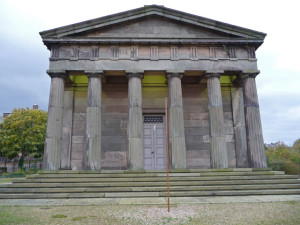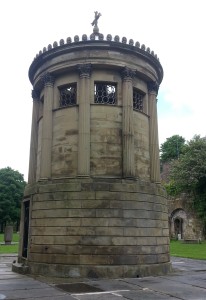A Grade I listed building that is described by English Heritage as ‘one of the purest monuments of Greek revival in England’ hardly gets a mention when the great buildings of Liverpool are talked about due to its more illustrious neighbour.
Situated just to the north of Liverpool Cathedral is The Oratory, a chapel that was built in 1829 where services were held prior to burials in St James’ Cemetery. Designed by John Foster, who also designed nearby St Andrew’s Church and assisted his father with St Luke’s (the bombed out church), it is considered by some architectural critics to be his finest building. It has no windows, receiving light from above and has a portico of six columns at either end. Inside there is a coffered ceiling, made up of hundreds of square panels held up by ionic columns.
The Oratory opened in 1829 at the same time as the cemetery, situated in a disused quarry and also designed by Foster. It relieved pressure on the Necropolis in Everton, where hardly a burial could take place without another corpse being disturbed. The Oratory remained in use for over 100 years, sometimes hosting eight services a day. In 1936, after 57,774 burials, St James’ finally closed as it was considered to have reached its capacity.
In the 1970s most of the gravestones were removed and the cemetery landscaped over and renamed Cathedral Gardens. Certain notable graves do remain, such as that of Kitty Wilkinson, founder of the washhouse and in the middle is the grandest tomb of all, that of William Huskisson, local MP and President of the Board of Trade who was killed during the opening of the Liverpool & Manchester Railway in 1830.
Of all the funerals to have taken place there, Huskisson’s was quite possibly the largest, attracting up to 30,000 onlookers. He had been run over by an engine whilst crossing the track near Newton le Willows during a break in the opening day of the world’s first passenger railway. He was taken to Manchester but his injuries were too severe to be saved. His funeral took place on 24th September 1830, nine days after his death and was reported at length in the Liverpool Mercury., which said that it was witnessed by ‘the largest concourse of mourners that ever assembled in this town.’
The funeral procession of nine carriages began at the Town Hall and went along Castle Street before turning left into Lord Street, continuing into Church Street, Bold Street and right into Slater Street. All along the route temporary railings had been erected for crowd control and many climbed onto roofs of buildings to get a better view. It then did another left turn into Duke Street and headed up to the cemetery, a distance of nearly two miles. Chief mourners went into the Oratory for a short services lasting fifteen minutes, while 6,000 ticket holders took up position in the cemetery. A further 20-30,000 were estimated to be looking on from vantage points.The Reverend Jonathan Brooks, Rector of Liverpool, said prayers by the graveside before Huskisson’s coffin was lowered into the ground and the crowd then dispersed with great decorum. The grave was then entombed by a circular monument that was also designed by John Foster.
Since the closure of the cemetery, the Oratory lay unused as the magnificent cathedral, the fifth largest in the world, grew next to it. The foundation stone had been laid by Edward VII in 1904 and the tower was topped out in 1942, with the building being finally completed in 1978. The Oratory was designated a Grade I listed building in 1952, with the National Heritage List describing it as ‘one of the purest monuments of the Greek Revival in England.’ The railings are Grade II listed and within them is a Crimean War memorial.
In 1986 National Museums & Galleries on Merseyside (now National Museums Liverpool) took over the building and have housed a number of statues and busts in there, including one of Huskisson and also of Agnes Jones, the first trained Nursing Superintendent of the Liverpool Workhouse. It is not generally open to the public, except on special occasions.




Recent Comments